 Technology peripherals
Technology peripherals
 AI
AI
 Efficient parameter fine-tuning of large-scale language models--BitFit/Prefix/Prompt fine-tuning series
Efficient parameter fine-tuning of large-scale language models--BitFit/Prefix/Prompt fine-tuning series
Efficient parameter fine-tuning of large-scale language models--BitFit/Prefix/Prompt fine-tuning series
In 2018, Google released BERT. Once it was released, it defeated the State-of-the-art (Sota) results of 11 NLP tasks in one fell swoop, becoming a new milestone in the NLP world; The structure of BERT is shown in the figure below , The left side is the BERT model pre-training process, and the right side is the fine-tuning process for specific tasks. Among them, the fine-tuning stage is for fine-tuning when it is subsequently used in some downstream tasks, such as: text classification, part-of-speech tagging, question and answer system, etc. BERT can be fine-tuned on different tasks without adjusting the structure. Through the task design of "pre-training language model and downstream task fine-tuning", it has brought powerful model effects. Since then, "pre-training language model and downstream task fine-tuning" has become the mainstream training paradigm in the field of NLP.
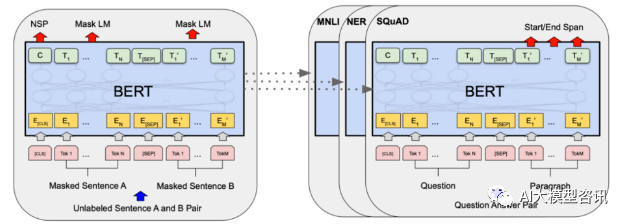 BERT structure diagram, the left side is the pre-training process, and the right side is the specific task fine-tuning process
BERT structure diagram, the left side is the pre-training process, and the right side is the specific task fine-tuning process
However, with the emergence of large-scale architectures represented by GPT3, As the parameter size of large-scale language models (LLM) increases, full fine-tuning on consumer-grade hardware becomes unfeasible. The following table shows the CPU/GPU memory consumption of full model fine-tuning and parameter efficient fine-tuning on an A100 GPU (80G video memory) and hardware with a CPU memory of 64GB or more
 Full Comparison of memory usage between parameter fine-tuning and parameter efficient fine-tuning
Full Comparison of memory usage between parameter fine-tuning and parameter efficient fine-tuning
In addition, comprehensive fine-tuning of the model will also lead to the loss of diversity and serious forgetting problems. Therefore, how to efficiently perform model fine-tuning has become the focus of industry research, which also provides research space for the rapid development of efficient parameter fine-tuning technology
Efficient parameter fine-tuning refers to fine-tuning a small amount or additional model parameters, with a fixed large Partially pre-trained model (LLM) parameters, thereby greatly reducing computing and storage costs, while also achieving performance comparable to full parameter fine-tuning. The parameter efficient fine-tuning method is even better than full fine-tuning in some cases, and can be better generalized to out-of-domain scenarios.
Efficient fine-tuning technology can be roughly divided into the following three categories, as shown in the figure below: adding additional parameters (A), selecting a part of parameters to update (S), and introducing heavy parameterization (R). Among the methods of adding additional parameters, they are mainly divided into two subcategories: Adapter-like methods and Soft prompts.
Common parameter efficient fine-tuning technologies include BitFit, Prefix Tuning, Prompt Tuning, P-Tuning, Adapter Tuning, LoRA, etc. The following chapters will explain in detail some mainstream efficient parameter fine-tuning methods
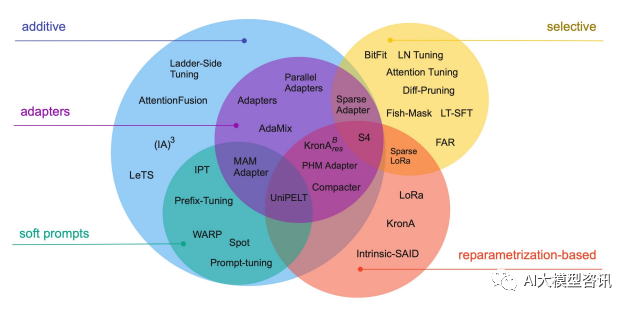 Common parameter efficient fine-tuning technologies and methods
Common parameter efficient fine-tuning technologies and methods
BitFit/Prefix/Prompt Fine-tuning Series
BitFit
Although full fine-tuning for each task is very effective, it will also generate a Uniquely large models, which make it difficult to infer what changes occurred during fine-tuning, are also difficult to deploy, and especially difficult to maintain as the number of tasks increases.
Ideally, we hope to have an efficient fine-tuning method that meets the following conditions:
The above issues depend on the extent to which the fine-tuning process can guide the learning of new abilities and exposure to pre-training LM secondary schools ability. Although, the previous efficient fine-tuning methods Adapter-Tuning and Diff-Pruning can also partially meet the above needs. BitFit, a sparse fine-tuning method with smaller parameters, can meet all the above needs.
BitFit is a sparse fine-tuning method that only updates the bias parameters or part of the bias parameters during training. For the Transformer model, most of the transformer-encoder parameters are frozen, and only the bias parameters and the classification layer parameters of the specific task are updated. The bias parameters involved include the bias involved in calculating query, key, value and merging multiple attention results in the attention module, the bias in the MLP layer, the bias parameter in the Layernormalization layer, and the bias parameters in the pre-training model as shown in the figure below. .
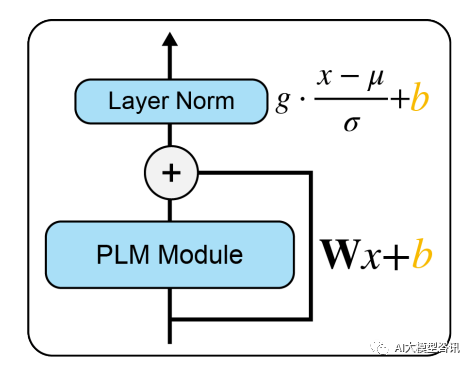 Picture
Picture
The PLM module represents a specific PLM sub-layer, such as attention or FFN. The orange block in the figure indicates the trainable Hint vector, blue blocks represent frozen pre-trained model parameters
In models such as Bert-Base/Bert-Large, the bias parameter only accounts for 0.08%~0.09% of the total parameters of the model. However, by comparing the effects of BitFit, Adapter and Diff-Pruning on the Bert-Large model based on the GLUE data set, it was found that BitFit has the same effect as Adapter and Diff-Pruning when the number of parameters is much smaller than that of Adapter and Diff-Pruning. , even slightly better than Adapter and Diff-Pruning in some tasks.
It can be seen from the experimental results that compared to the fine-tuning of all parameters, the BitFit fine-tuning results only updated a very small number of parameters, and achieved good results on multiple data sets. Although it is not as good as fine-tuning all parameters, it is far better than the Frozen method of fixing all model parameters. At the same time, by comparing the parameters before and after BitFit training, it was found that many bias parameters did not change much, such as the bias parameters related to calculating the key. It is found that the bias parameters of the FFN layer that calculates the query and enlarges the feature dimension from N to 4N have the most obvious changes. Only updating these two types of bias parameters can also achieve good results. On the contrary, if any one of them is fixed, the effect of the model will be greatly lost.
Prefix Tuning
The work before Prefix Tuning was mainly to manually design discrete templates or automatically search for discrete templates. For manually designed templates, changes in the template are particularly sensitive to the final performance of the model. Adding a word, missing a word, or changing the position will cause relatively large changes. For automated search templates, the cost is relatively high; at the same time, the results of previous discrete token searches may not be optimal. In addition, the traditional fine-tuning paradigm uses pre-trained models to fine-tune different downstream tasks, and a fine-tuned model weight must be saved for each task. On the one hand, fine-tuning the entire model takes a long time; on the other hand, it will also Takes up a lot of storage space. Based on the above two points, Prefix Tuning proposes a fixed pre-training LM, adding trainable, task-specific prefixes to LM, so that different prefixes can be saved for different tasks, and the fine-tuning cost is also small; at the same time, this kind of Prefix is actually Continuously differentiable Virtual Token (Soft Prompt/Continuous Prompt) is better optimized and has better effect than discrete Token.
So, what needs to be rewritten is: So what is the meaning of prefix? The role of prefix is to guide the model to extract information related to x, so as to better generate y. For example, if we want to do a summary task, then after fine-tuning, prefix can understand that what we are currently doing is a "summarization form" task, and then guide the model to extract key information from x; if we want to do an emotion classification Task, prefix can guide the model to extract the semantic information related to emotion in x, and so on. This explanation may not be so rigorous, but you can roughly understand the role of prefix
Prefix Tuning is to construct a task-related virtual tokens as Prefix before inputting the token, and then only update the parameters of the Prefix part during training. , while other parameters in PLM are fixed. For different model structures, different Prefixes need to be constructed:
- For autoregressive architecture models: add a prefix in front of the sentence to get z = [PREFIX; x; y]. The appropriate above can be in With the LM fixed, guide the generation of context (for example: context learning of GPT3).
- For the encoder-decoder architecture model: Prefixes are added to both Encoder and Decoder, resulting in z = [PREFIX; x; PREFIX0; y]. The prefix is added on the Encoder side to guide the encoding of the input part, and the prefix is added on the Decoder side to guide subsequent token generation.
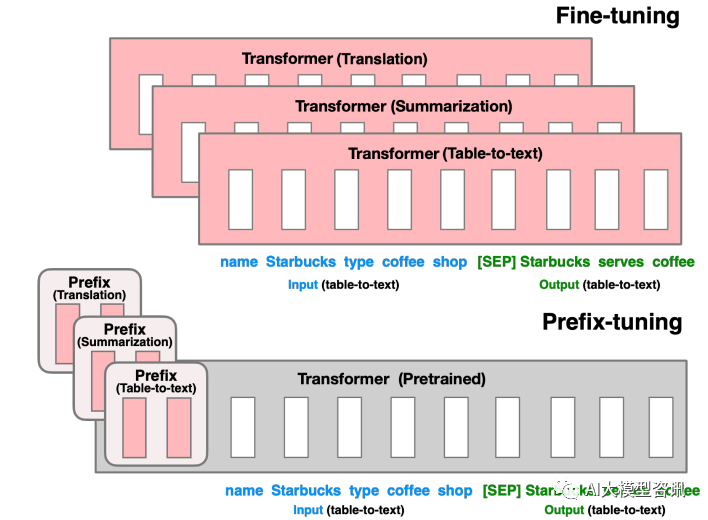 Picture
Picture
Rewrite the content without changing the original meaning, and rewrite it in Chinese: For the fine-tuning in the previous part, we update all Transformer parameters (red box) and need to store a complete copy of the model for each task. The prefix adjustment in the lower part will freeze the Transformer parameters and only optimize the prefix (red box)
This method is actually similar to constructing Prompt, except that Prompt is an artificially constructed "explicit" prompt. And the parameters cannot be updated, while Prefix is an "implicit" hint that can be learned. At the same time, in order to prevent the direct update of the parameters of Prefix from causing unstable training and performance degradation, an MLP structure is added in front of the Prefix layer. After training is completed, only the parameters of Prefix are retained. In addition, ablation experiments have proven that adjusting the embedding layer alone is not expressive enough, which will lead to a significant performance decline. Therefore, prompt parameters are added to each layer, which is a major change.
Although Prefix Tuning seems convenient, it also has the following two significant disadvantages:
Prompt Tuning
Full fine-tuning of large models requires training a model for each task, which has relatively high overhead and deployment costs. At the same time, the discrete prompts (referring to manually designing prompts and adding prompts to the model) method is relatively expensive and the effect is not very good. Prompt Tuning learns prompts by backpropagating updated parameters instead of manually designing prompts; at the same time, it freezes the original weights of the model and only trains prompts parameters. After training, the same model can be used for multi-task inference.
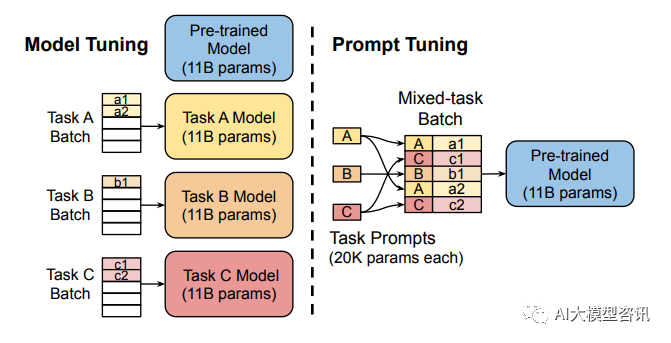 Picture
Picture
Model tuning requires making task-specific copies of the entire pre-trained model for each task. Downstream tasks and inference must be in separate batches . Prompt Tuning only requires storing a small task-specific prompt for each task and enables mixed-task inference using the original pre-trained model.
Prompt Tuning can be seen as a simplified version of Prefix Tuning. It defines its own prompt for each task, and then splices it into the data as input, but only adds prompt tokens to the input layer, and There is no need to add MLP for adjustment to solve difficult training problems.
It was found through experiments that as the number of parameters of the pre-trained model increases, the Prompt Tuning method will approach the results of full parameter fine-tuning. At the same time, Prompt Tuning also proposed Prompt Ensembling, which means training different prompts for the same task at the same time in a batch (that is, asking the same question in multiple different ways). This is equivalent to training different models. For example The cost of model integration is much smaller. In addition, the Prompt Tuning paper also discusses the impact of the initialization method and length of the Prompt token on model performance. Through ablation experiment results, it is found that Prompt Tuning uses class labels to initialize the model better than random initialization and initialization using sample vocabulary. However, as the model parameter scale increases, this gap will eventually disappear. When the length of Prompt token is around 20, the performance is already good (after exceeding 20, increasing the length of Prompt token will not significantly improve the performance of the model). Similarly, this gap will also decrease as the scale of model parameters increases ( That is, for very large-scale models, even if the Prompt token length is very short, it will not have much impact on performance).
The above is the detailed content of Efficient parameter fine-tuning of large-scale language models--BitFit/Prefix/Prompt fine-tuning series. For more information, please follow other related articles on the PHP Chinese website!

Hot AI Tools

Undresser.AI Undress
AI-powered app for creating realistic nude photos

AI Clothes Remover
Online AI tool for removing clothes from photos.

Undress AI Tool
Undress images for free

Clothoff.io
AI clothes remover

Video Face Swap
Swap faces in any video effortlessly with our completely free AI face swap tool!

Hot Article

Hot Tools

Notepad++7.3.1
Easy-to-use and free code editor

SublimeText3 Chinese version
Chinese version, very easy to use

Zend Studio 13.0.1
Powerful PHP integrated development environment

Dreamweaver CS6
Visual web development tools

SublimeText3 Mac version
God-level code editing software (SublimeText3)

Hot Topics
 1389
1389
 52
52
 Understand Tokenization in one article!
Apr 12, 2024 pm 02:31 PM
Understand Tokenization in one article!
Apr 12, 2024 pm 02:31 PM
Language models reason about text, which is usually in the form of strings, but the input to the model can only be numbers, so the text needs to be converted into numerical form. Tokenization is a basic task of natural language processing. It can divide a continuous text sequence (such as sentences, paragraphs, etc.) into a character sequence (such as words, phrases, characters, punctuation, etc.) according to specific needs. The units in it Called a token or word. According to the specific process shown in the figure below, the text sentences are first divided into units, then the single elements are digitized (mapped into vectors), then these vectors are input to the model for encoding, and finally output to downstream tasks to further obtain the final result. Text segmentation can be divided into Toke according to the granularity of text segmentation.
 Three secrets for deploying large models in the cloud
Apr 24, 2024 pm 03:00 PM
Three secrets for deploying large models in the cloud
Apr 24, 2024 pm 03:00 PM
Compilation|Produced by Xingxuan|51CTO Technology Stack (WeChat ID: blog51cto) In the past two years, I have been more involved in generative AI projects using large language models (LLMs) rather than traditional systems. I'm starting to miss serverless cloud computing. Their applications range from enhancing conversational AI to providing complex analytics solutions for various industries, and many other capabilities. Many enterprises deploy these models on cloud platforms because public cloud providers already provide a ready-made ecosystem and it is the path of least resistance. However, it doesn't come cheap. The cloud also offers other benefits such as scalability, efficiency and advanced computing capabilities (GPUs available on demand). There are some little-known aspects of deploying LLM on public cloud platforms
 To provide a new scientific and complex question answering benchmark and evaluation system for large models, UNSW, Argonne, University of Chicago and other institutions jointly launched the SciQAG framework
Jul 25, 2024 am 06:42 AM
To provide a new scientific and complex question answering benchmark and evaluation system for large models, UNSW, Argonne, University of Chicago and other institutions jointly launched the SciQAG framework
Jul 25, 2024 am 06:42 AM
Editor |ScienceAI Question Answering (QA) data set plays a vital role in promoting natural language processing (NLP) research. High-quality QA data sets can not only be used to fine-tune models, but also effectively evaluate the capabilities of large language models (LLM), especially the ability to understand and reason about scientific knowledge. Although there are currently many scientific QA data sets covering medicine, chemistry, biology and other fields, these data sets still have some shortcomings. First, the data form is relatively simple, most of which are multiple-choice questions. They are easy to evaluate, but limit the model's answer selection range and cannot fully test the model's ability to answer scientific questions. In contrast, open-ended Q&A
 Efficient parameter fine-tuning of large-scale language models--BitFit/Prefix/Prompt fine-tuning series
Oct 07, 2023 pm 12:13 PM
Efficient parameter fine-tuning of large-scale language models--BitFit/Prefix/Prompt fine-tuning series
Oct 07, 2023 pm 12:13 PM
In 2018, Google released BERT. Once it was released, it defeated the State-of-the-art (Sota) results of 11 NLP tasks in one fell swoop, becoming a new milestone in the NLP world. The structure of BERT is shown in the figure below. On the left is the BERT model preset. The training process, on the right is the fine-tuning process for specific tasks. Among them, the fine-tuning stage is for fine-tuning when it is subsequently used in some downstream tasks, such as text classification, part-of-speech tagging, question and answer systems, etc. BERT can be fine-tuned on different tasks without adjusting the structure. Through the task design of "pre-trained language model + downstream task fine-tuning", it brings powerful model effects. Since then, "pre-training language model + downstream task fine-tuning" has become the mainstream training in the NLP field.
 Meta launches AI language model LLaMA, a large-scale language model with 65 billion parameters
Apr 14, 2023 pm 06:58 PM
Meta launches AI language model LLaMA, a large-scale language model with 65 billion parameters
Apr 14, 2023 pm 06:58 PM
According to news on February 25, Meta announced on Friday local time that it will launch a new large-scale language model based on artificial intelligence (AI) for the research community, joining Microsoft, Google and other companies stimulated by ChatGPT to join artificial intelligence. Intelligent competition. Meta's LLaMA is the abbreviation of "Large Language Model MetaAI" (LargeLanguageModelMetaAI), which is available under a non-commercial license to researchers and entities in government, community, and academia. The company will make the underlying code available to users, so they can tweak the model themselves and use it for research-related use cases. Meta stated that the model’s requirements for computing power
 RoSA: A new method for efficient fine-tuning of large model parameters
Jan 18, 2024 pm 05:27 PM
RoSA: A new method for efficient fine-tuning of large model parameters
Jan 18, 2024 pm 05:27 PM
As language models scale to unprecedented scale, comprehensive fine-tuning for downstream tasks becomes prohibitively expensive. In order to solve this problem, researchers began to pay attention to and adopt the PEFT method. The main idea of the PEFT method is to limit the scope of fine-tuning to a small set of parameters to reduce computational costs while still achieving state-of-the-art performance on natural language understanding tasks. In this way, researchers can save computing resources while maintaining high performance, bringing new research hotspots to the field of natural language processing. RoSA is a new PEFT technique that, through experiments on a set of benchmarks, is found to outperform previous low-rank adaptive (LoRA) and pure sparse fine-tuning methods using the same parameter budget. This article will go into depth
 Conveniently trained the biggest ViT in history? Google upgrades visual language model PaLI: supports 100+ languages
Apr 12, 2023 am 09:31 AM
Conveniently trained the biggest ViT in history? Google upgrades visual language model PaLI: supports 100+ languages
Apr 12, 2023 am 09:31 AM
The progress of natural language processing in recent years has largely come from large-scale language models. Each new model released pushes the amount of parameters and training data to new highs, and at the same time, the existing benchmark rankings will be slaughtered. ! For example, in April this year, Google released the 540 billion-parameter language model PaLM (Pathways Language Model), which successfully surpassed humans in a series of language and reasoning tests, especially its excellent performance in few-shot small sample learning scenarios. PaLM is considered to be the development direction of the next generation language model. In the same way, visual language models actually work wonders, and performance can be improved by increasing the scale of the model. Of course, if it is just a multi-tasking visual language model
 BLOOM can create a new culture for AI research, but challenges remain
Apr 09, 2023 pm 04:21 PM
BLOOM can create a new culture for AI research, but challenges remain
Apr 09, 2023 pm 04:21 PM
Translator | Reviewed by Li Rui | Sun Shujuan BigScience research project recently released a large language model BLOOM. At first glance, it looks like another attempt to copy OpenAI's GPT-3. But what sets BLOOM apart from other large-scale natural language models (LLMs) is its efforts to research, develop, train, and release machine learning models. In recent years, large technology companies have hidden large-scale natural language models (LLMs) like strict trade secrets, and the BigScience team has put transparency and openness at the center of BLOOM from the beginning of the project. The result is a large-scale language model that can be studied and studied, and made available to everyone. B



